

In the Wild
Compare kakariki feathers with those from other species: the cockatiel (A) from the deserts of
Australia and the green-cheek conure (B) from tropical Brazil.
Noise
Lifespan
Sexing
Weaknesses
Baldness is common in kaks, particularly hens. Not all birds seem to have this problem. The feathers usually grow in during a molt and the bird will look perfect for a week or so, but then the feathers will drop out again. The cause may be genetic (kaks aren't very common in the U.S. and many have been inbred) or overzealous preening on the part of the male. Kaks seem to drop feathers quite easily, so I can see how a little rough preening would knock quite a few out. My hens look really ratty in the breeding season.
Many of you have reported seizures or strange trances in your pet kaks, and have asked me if this is normal. This year was the first time I'd ever experienced it in my own flock. I placed my male yellow-fronted kak in a brown paper bag so that I could weigh him. When I took him out, he lay on the ground and appeared to be dying. I immediately rushed him to the vet, certain that he would be dead when we arrived. Instead he slowly started acting normal again- first he stood up and wobbled around, and soon he was hopping about the cage. By the time my vet saw him, he was acting normally. My vet (an excellent avian vet, by the way) told me that some species go into weird trances or even have seizures when certain procedures are done. She said that it really freaks out the owners, but it is perfectly normal. I can't remember all the species she mentioned, but she said Meyers parrots would go into seizures when their nails were trimmed. Odd and frightening, but they always snapped out of it eventually. Like I said, I've gotten numerous letters about seizures, trances and stumbling in kaks, so it appears that they may be one of the species that reacts like this.
Husbandry
Breeding
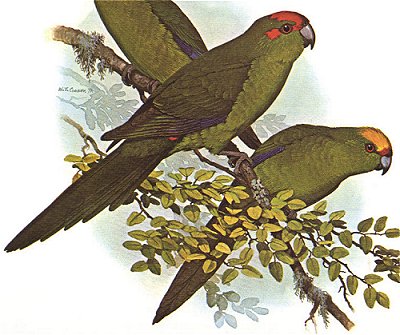 This information pertains to the red-fronted kakariki (C. novazelandiae) but
most of it can also be used for yellow-fronts (C. auriceps).
This information pertains to the red-fronted kakariki (C. novazelandiae) but
most of it can also be used for yellow-fronts (C. auriceps).
Kakarikis are native to New Zealand. There are several
species, most of which are endangered or extinct. New Zealand is a small bunch of islands
southeast of Australia and
like most islands it has very unique wildlife. Until man came, there were no mammals. Because
of this the birds evolved to fit in the gaps. Many of them became flightless- they had no fear
of predators. But when man brought mammals like cats, weasels and rats most of the native birds
were wiped out. Luckily the kakariki can fly. Still, they spend as much time on the ground as
they do in the trees. They have long feet and toes and love to scratch about on the ground like
chickens. Their feathers are also elongated and fluffy to help protect them from the cold (New
Zealand is right above Antarctica).
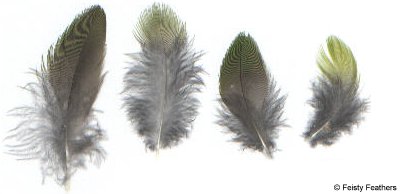
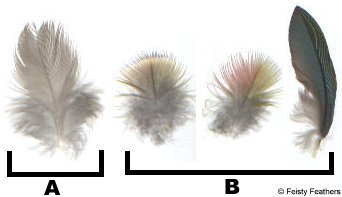
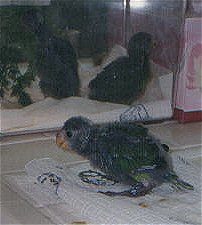 The down is concentrated near
the skin and the tips are dense when compared with those of other species. Elongated feathers
can be erected to trap heat near the body (ever notice how your arm hairs will stand erect when
you're cold?). Unfortunately these adaptations can work against them in captivity. Kaks can
overheat easily.
The down is concentrated near
the skin and the tips are dense when compared with those of other species. Elongated feathers
can be erected to trap heat near the body (ever notice how your arm hairs will stand erect when
you're cold?). Unfortunately these adaptations can work against them in captivity. Kaks can
overheat easily.
Kaks have a very pleasant "wa wa wa" sound and males can be talented talkers.
I've read 10 years but I suspect they can live at least 25.
Kaks are dimorphic so there's no need for DNA or surgical sexing
as long as you know what to look for. It's pretty obvious. Males are about 15 grams heavier
than females and also have bigger heads and wider beaks. The females look very thin and dainty.
Most males also seem to have a brighter shade of red than hens.
Chicks can be sexed by the width of their beaks when their pinfeathers are just beginning to
open. Use the following pictures as a guide to sexing your kaks.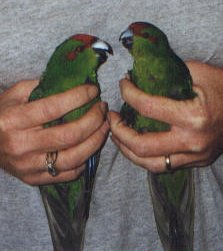
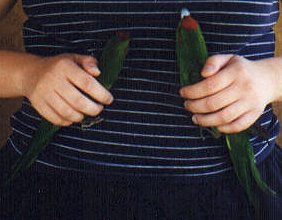
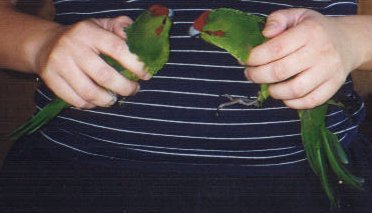
Kaks may be susceptible to aspergillosis infections. With the exception of one, every adult kak I've lost died of this. I've never had a case of aspergillosis in any of my other species. However, I have yet to confirm this problem with other kak breeders. It may be something isolated to my aviary.
Kaks are very busy birds who want to be everywhere at once. They're the only psittacine I feel
sorry clipping wings for. Breeders should definately be kept in an flight and pets should be
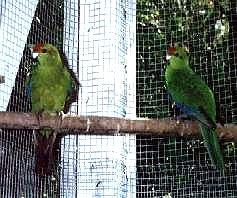 let out as often as possible. Since kaks are so curious you should make triple-sure that there
are no hazards in or around the cage. And be wary of escapes! I've seen my kaks perform
somersaults in the air to avoid a net. Feed cups should be covered. These guys will flick food
everywhere with their scratching behavior. Also, kaks do enjoy running around upside down on
the ceiling so I'd advise at least part of the cage ceiling be wire.
let out as often as possible. Since kaks are so curious you should make triple-sure that there
are no hazards in or around the cage. And be wary of escapes! I've seen my kaks perform
somersaults in the air to avoid a net. Feed cups should be covered. These guys will flick food
everywhere with their scratching behavior. Also, kaks do enjoy running around upside down on
the ceiling so I'd advise at least part of the cage ceiling be wire.
The first thing you need to make certain of is that your birds are not hybrids. Red-fronts only
have red and it's found on the crown, back past the eye, as a sort of stripe leading to eye
and as a spot behind the eye. Yellow-crowns do not have the stripe or the spot near the eye, but
have a small patch of red just above the cere and a yellow patch
extending past over the eye. Hybrids look like yellow-crowns with a more orange color and
sometimes a partial spot or stripe.

Kaks can be bred similarly to cockatiels and Aussie parakeets. I'd advise only keeping one pair per aviary due to their curious nature. If offered multiple nestboxes they will start a clutch in one box and when the first clutch gets older the hen may start a new clutch in the second box while the male finishes raising the first. They are very prolific for their size (females about 55 grams and males about 75), laying 8-12 eggs. Often the hen cannot properly incubate such a large clutch and some may have to be taken out. Babies quickly begin to look like parents so banding is a good idea (banding is a good idea anyway). For a week or so after fledging their beaks will be beige but then will turn the typical silver tipped with black.
Diet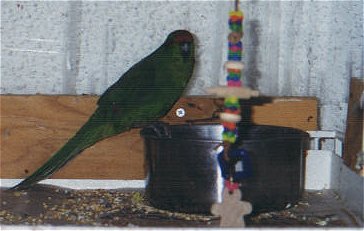 Regular psittacine diet. While most of my birds go right for the corn
in their frozen veggies mix, the kaks eat the peas first. One of the most wonderful traits about
kaks is that they are so curious. Not only does this make taming a cinch but conversion to pellets
as well. With most kaks, this is as simple as adding a bowl of pellets next to the seed dish for
a day and then removing the seed the day after (just make sure they're eating it if you switch cold
turkey like this).
Regular psittacine diet. While most of my birds go right for the corn
in their frozen veggies mix, the kaks eat the peas first. One of the most wonderful traits about
kaks is that they are so curious. Not only does this make taming a cinch but conversion to pellets
as well. With most kaks, this is as simple as adding a bowl of pellets next to the seed dish for
a day and then removing the seed the day after (just make sure they're eating it if you switch cold
turkey like this).
Personality/Behavior
Kaks were what inspired me to name my business Feisty Feathers. They're a lot like big budgies-
very animated, playful and chatty, but not too pettable. I've handfed both budgies and kaks.
It's a joke. They want to be fed but they're too hyper to sit still and feed. They want to
over there or doing at that. It's a miracle to get their crops completely full.
Kaks make very entertaining pets if you can handle a bird that will get into everything.

© 1999-2003 Feisty Feathers